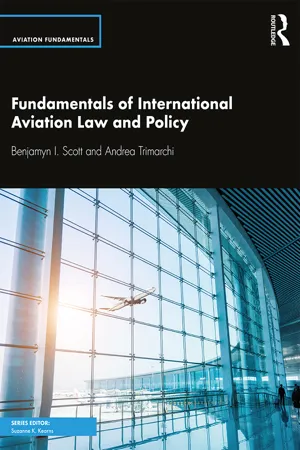
Fundamentals of International Aviation Law and Policy
- 298 pages
- English
- ePUB (mobile friendly)
- Available on iOS & Android
Fundamentals of International Aviation Law and Policy
About this book
Fundamentals of International Aviation Law and Policy offers students a systematic, tailored and dynamic approach to understanding the legal scenario concerning international civil aviation. The book dynamically covers the major areas of international aviation law, and provides an introduction to the multifaceted international regulation of aviation activities in the sphere of public and private law.
The book is designed to provide the reader with the fundamental notions concerning international aviation law. It adopts an interactive approach, which aims at engaging the reader by way of using learning tools. The main areas of public and private aviation law are dealt with from a regulatory and practical perspective, and include detailed analyses of existing and applicable legislations, as well as landmark court cases and decisions. Each chapter is tailored to confer to readers a thorough knowledge of the international and, if any, the European applicable legislation. Delivery of these aims is attained through a dynamic and balanced use of didactic instruments and immediate information.
The book is intended for a varied audience of students and professionals involved in the aviation world, without requiring the possession of specific legal knowledge or background. It also aims to constitute a useful reference material for those who are familiar with legal terminology and aviation specifics.
Frequently asked questions
- Essential is ideal for learners and professionals who enjoy exploring a wide range of subjects. Access the Essential Library with 800,000+ trusted titles and best-sellers across business, personal growth, and the humanities. Includes unlimited reading time and Standard Read Aloud voice.
- Complete: Perfect for advanced learners and researchers needing full, unrestricted access. Unlock 1.4M+ books across hundreds of subjects, including academic and specialized titles. The Complete Plan also includes advanced features like Premium Read Aloud and Research Assistant.
Please note we cannot support devices running on iOS 13 and Android 7 or earlier. Learn more about using the app.
Information
CHAPTER 1
Foundations of
Aviation Law
1.1 Introduction
1.1.1 Aviation v. Air Law
1.1.2 What is Aviation Law?
| Existing | Separate | Autonomous |
| Aviation law is simply a part of existing larger divisions of law, such as contract, criminal and tort, which concern aviation stakeholders. | Aviation law is separate from other areas of law and stands by itself. | Whatever its origins (Existing or Separate), aviation law has evolved into an autonomous body of law that allows for the production of new laws. |
1.2 Key Elements in Aviation Law
Table of contents
- Cover Page
- Half Title Page
- Series Page
- Title Page
- Copyright Page
- Table of Contents
- Foreword
- Acknowledgements
- Acronyms and Abbreviations
- Biography
- Learning Tools
- Legal texts
- Court cases
- 1 Foundations of Aviation Law
- 2 Early Development in Aviation Law
- 3 Convention on International Civil Aviation
- 4 International Civil Aviation Organization
- 5 International Air Transport
- 6 Criminal Aviation Law
- 7 Contractual Liability
- 8 Third-Party Liability and Damage on the Surface
- 9 Aviation Insurance
- 10 Aviation Competition Law
- 11 Regulation of Environment in Aviation
- 12 Suborbital Transportation and the Link to Space Law
- Annex I – List of Main International Aviation Law Treaties
- Index